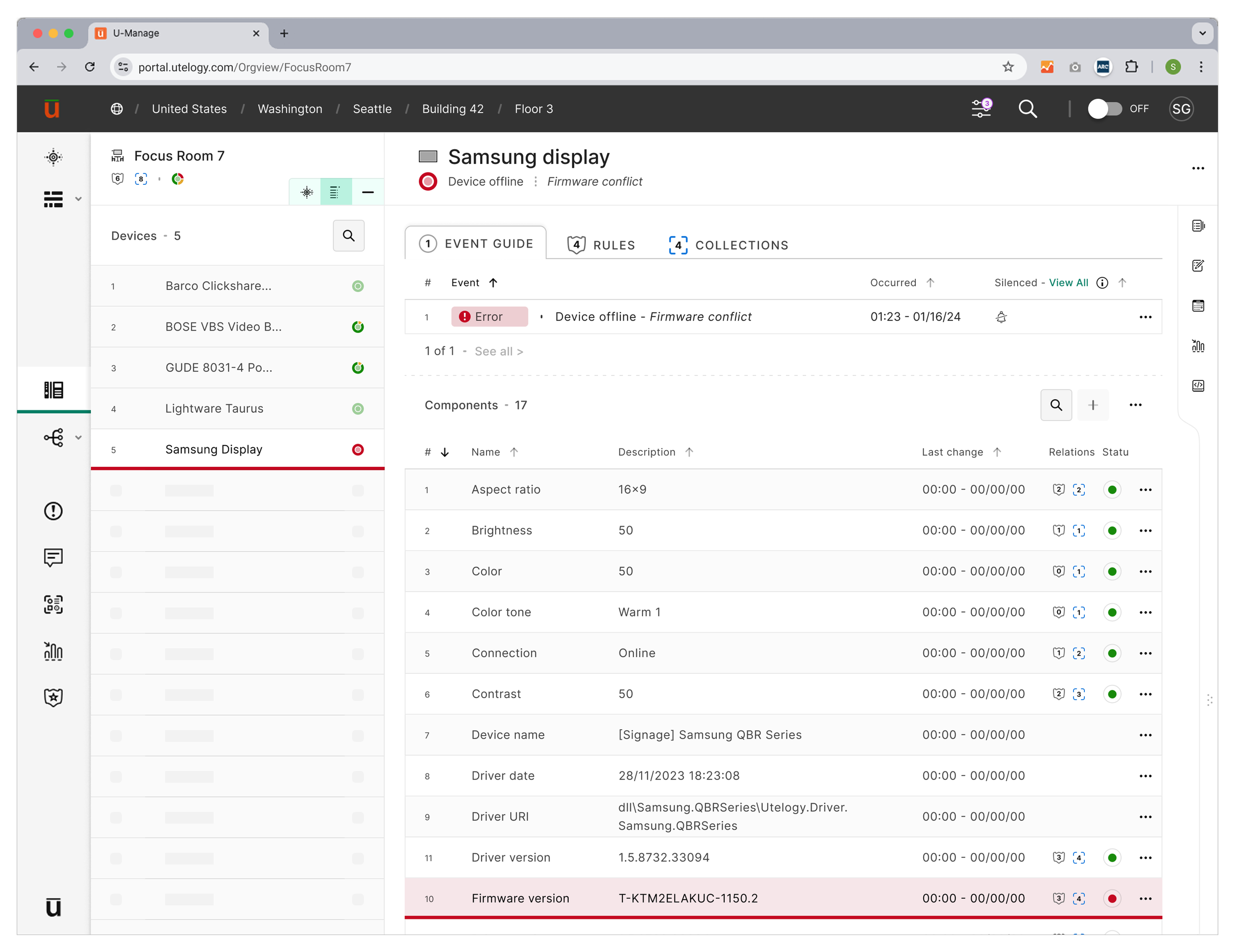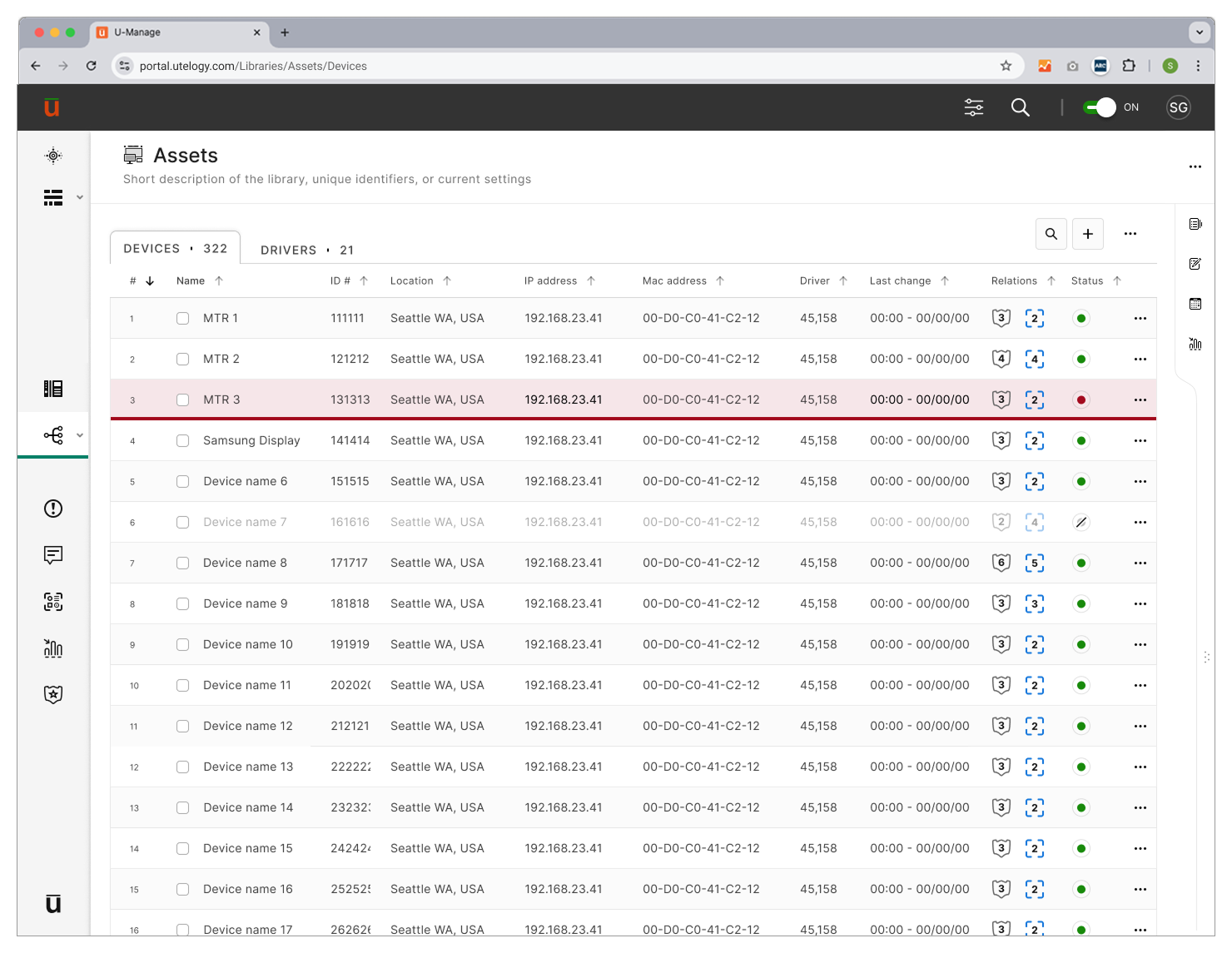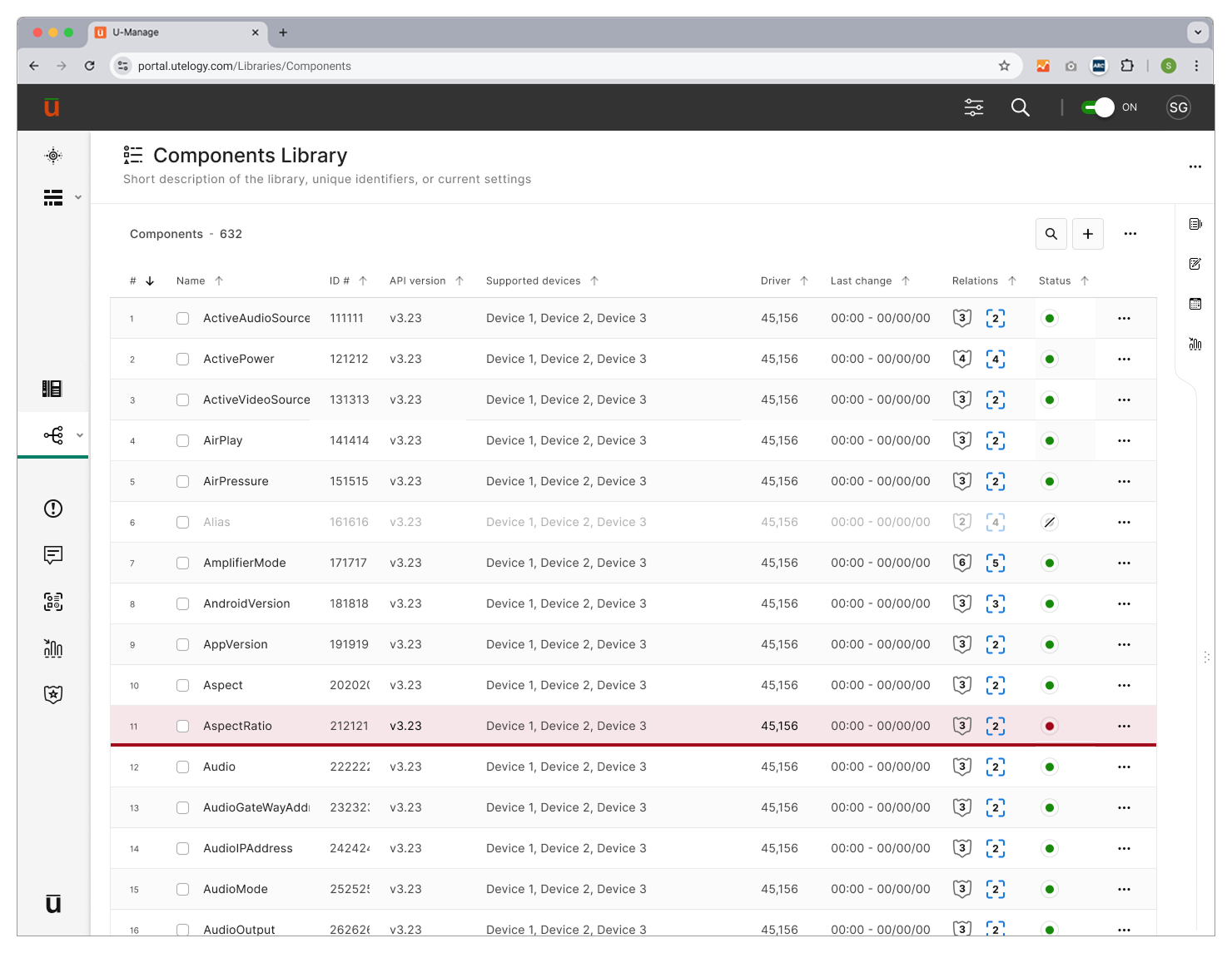Utelogy - Product team
Led a User-Centered Design program at Utelogy, helping the startup grow through outcome-focused, customer-driven experiences
I led research and discovery, design direction, and strategic vision for Utelogy’s next-generation energy and resource management platform, enabling a scalable architecture, powering AI integration, cloud-centric workflows, and digital twin capabilities. The platform provides device-agnostic control, advanced analytics, and role-based visibility, delivering targeted and actionable insights.
Timeframe: Jan ’23 – Nov ‘24
Team: Senior UX Designer (Me), CTO, CPO, 2PMs, 4x Engineers
My work: Research, Design system, 0-1 innovation, ML/AI-enhanced UX, Digital Twin technology
SITUATION:
Utelogy provided a suite of software solutions for managing audiovisual (AV) systems across enterprise, education, government, and managed service provider (MSP) environments. The product portfolio included:
U-Manage – a cloud-based platform for centralized management, monitoring, and analytics (including U-Automate, U-Scheduling, Tech Tool, U-Analytics, and U-Control).
U-Enterprise – an on-premise system for AV control (including U-Server, U-Control, U-Computer, and U-Console).
Over the last 10-12 years, the suite expanded in scope and complexity, with onboarding, training, and daily management requiring significant support from Utelogy teams. Users frequently context-switched between multiple disconnected applications, often copying data between systems to complete workflows, which slowed productivity and created friction in daily operations.
PROCESS:
I partnered closely with the CTO and CPO for nearly two years, building trust and alignment with internal engineering and support teams through cross-functional user research initiatives, data-driven design, workshops, leadership reviews, and UX office hours.
UX research and discovery methods included baseline onboarding research, onboarding audit, support team research, stakeholder research, and sustained use research. These studies were synthesized to detail user experience journeys and common points of friction for Managed Service Providers (MSPs) and AV organizational leaders.
Baseline onboarding usability research indicated that onboarding was not possible without heavy support and assistance. Users had to constantly context switch between multiple uncoordinated software solutions with no inline instruction or call-to-action.
Onboarding audit insights
82 Pages in Audit
Onboarding training required 6 workshops
652+ individual steps
253 content switches without call-to-action, requiring support intervention
21 required instances of saving during onboarding, with no call-to-action
2 hours of narrated videos (left to subjectivity)
3 1/2 days of in-person support team training - walking through the initial setup
8-10 days to successfully set up, with heavy technical support
Support team research insights indicated repeated day-to-day interactions with users on common points of friction. This research included focused interviews and participation in weekly support calls.
Stakeholder research to better understand the current roadmap prioritization.
Additional research on sustained use uncovered substantial UX friction
Ongoing customer use often required weekly support through Quality Assurance teams and recurring Q/A calls with product management.
Several high-value customers depended on full-time onsite Utelogy technical support to keep systems running.
With no contextual guidance to complete workflows within the UI, users encountered a high learning curve and had high difficulty navigating and managing their environments. Organizations incurred high support costs and slow adoption, creating a lack of confidence in sustained use.
“Theres too much custom configuration, its not user-friendly.”
- Manage Service Provider tech
I synthesized and shared research insights across teams to build a shared understanding of user journeys, intentions, and goals, enabling cross-functional alignment on the UX outcome (ideal user experience) and its success metrics to achieve it. These collaborations operationalized the research, fostered user-centered alignment, and directly informed the product roadmap.
UX OUTCOME:
Deliver a unified, cloud-based energy and resource management experience that simplifies complexity, builds user trust, and drives adoption through clarity, scalability, and measurable efficiency.
SUCCESS METRICS:
-
Establish an iterative user research program with ongoing engagement from MSPs, enterprise customers, and AV leaders.
Conduct continuous validation through interviews, usability studies, and prototype testing to inform product direction.
Create a shared research repository and insight framework to guide design decision-making
-
Define the solution architecture for a singular software solution that unifies all cloud-based and on-prem offerings, lowering engineering overhead through scalable usability patterns.
Enable an end-to-end, device-agnostic cloud-based experience, ensuring seamless functionality and accessibility across devices and environments.
-
Apply a layered information model with progressive disclosure, allowing users to see organizational status at a glance and drill into detailed data as needed.
Enable role-specific and alert-based perspectives, delivering tailored visibility and relevance based on user context and responsibility.
Provide consistency and clarity with scalable UX, ensuring ease of use, confidence, and long-term adoption, by teaching structure through onboarding, and reducing the complexity in sustainable use.
Ensure robust reporting through digital twin technology, offering visibility from individual components to organizational scale.
Enable clarity through data-driven insights, empowering decisive action across roles.
My user research and data-driven design guided two key initiatives:
Future product vision: defining the long-term strategic direction and technical innovation
Current platform refinement: improving scalability, consistency, and usability while reducing design and technical debt.
This dual-track approach delivered immediate short-term usability improvements for existing customers and established a scalable, customer-centric foundation that advanced Utelogy’s long-term strategic goals.
Legacy UI experience:

















































Additional design processes:
I created an iterative design direction through proof-of-concepts and fully functional prototypes, enabling visibility, feedback, and design vision solidification
Iterative design system creation, management, socialization, and documentation
OUTCOME:
I designed an end-to-end, single-pane platform that unified Utelogy’s resource management experiences, enhanced visibility and accessibility, and standardized modern usability patterns to lower the barrier to entry and educate users through use. The redesigned cloud-based solution introduced a more intuitive account creation and onboarding process, enabling users to establish organizational structures through a single sign-on while supporting both light and dark themes.
The new product experience introduced a layered information model with dashboards that:
provided instant high-level clarity
intelligent role-based alerting perspectives
clear call-to-action affordances to drill into specific events
clear systemized navigational structure that lowered cognitive load




Managed Service Providers (MSPs) and enterprise customers reported reduced cognitive load, less context switching, and greater clarity across organizational management workflows. University IT leaders found onboarding less resource-intensive, while all users demonstrated higher engagement, faster learning, and increased confidence through consistent patterns, ease of use, and predictable behavior across the platform.
The redesigned experience delivered an organizational structure with functionality hubs to manage assets, configurations, automations, and workflows, surfacing role-based, action-oriented visibility for critical issues through the dashboard. This eliminated the need to monitor multiple tools and touchpoints across the organization, driving significant operational efficiency and measurable cost savings.
Initial research indicated users were easily able to navigate this process with no training and very little prompting. Users were excited with the streamlined experience, found it intuitive, and were highly engaged in learning how to manage their AV systems and organizational footprint with greater confidence.
“The experience provides a more robust understanding of status across organizations at a glance, and I can easily understand how to dive into specific details I care most about when managing accounts.”
- Utelogy Senior Support Staff
Organizational view: comps include static mode, edit mode, and functionality wings















In validation testing with functional content and high-fidelity prototypes, users easily discovered and navigated the left-side menu, accessed additional functionality, and used dashboards to drill into detailed data. The modernized workflows and interaction patterns were met with enthusiasm, delivering a more seamless and intuitive experience. Research suggested a significant reduction in design debt, and with the platform now supported by a comprehensive design system and improved navigation, findings indicated measurable decreases in engineering and support overhead—positioning the product for scalable growth and long-term efficiency.
“I can honestly say that there is only one thing that upsets me with this experience. That is that we don’t have it now!”
- Utelogy Senior Support Staff
Functionality hubs:



Overall impact
The redesigned experience delivered:
Intelligent alerting and enhanced automation for proactive system management.
Self-healing capabilities that reduced downtime and maintenance overhead.
Actionable, real-time data visualizations with drill-down functionality for deeper insight.
Comprehensive visibility and alerting across all organizational tiers, resources, and geographies.
A unified design language that connected all Utelogy resource management tools through consistent patterns and workflows—supporting intuitive onboarding, sustained usability, and long-term adoption.
This redesign enhanced onboarding efficiency, improved ease of use, and facilitated continuous learning, while advancing product innovation, informing strategic investments, and aligning the user experience with Utelogy’s long-term business vision.

